[am4show have='p8;p9;p11;p38;p72;p77;p92;' guest_error='Guest error message' user_error='User error message' ]
Week 24: Plants, Animals and Bio Lab Challenge #1
We’re going to cover quite areas of biology in this course, including zoology, biochemistry, molecular biology, ecology, botany and more. We are going to discover how to be a real biologist in the field as well as learn the big concepts in biology and how they tie into both physics and chemistry.
Need graph paper? Download the right size here.
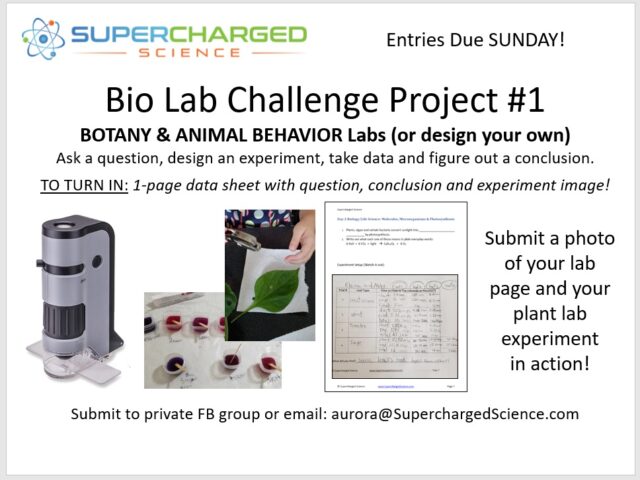
Bio Lab Challenge #1 Tip: You can do any one of the labs mentioned in the live sessions this week (Photosynthesis, Transpiration, Chromatography, or Animal Behavior), or you can design your own either from the suggested experiments (using the Experiment List) or creating your very own experiment based on what you are interested in studying. You do not need to complete ALL of these, just pick the one you are most interested in and do that one!
Microscope Recommendations
Compound microscopes are basically two lenses put together to make things appear larger. If you’ve ever used magnifying glass, you’ve noticed how the lens makes words easier to read. If you were to look through two magnifiers (one stacked on top of the other with space in between), you’ve seen this effect multiply to create an even larger image. That’s exactly what a compound microscope does. It uses stacked lenses to greatly increase the magnification.
The first thing you need to do is select a compound microscope. Cheap microscopes are going to frustrate you beyond belief, so we’ve provided recommendations that will get last your kids through college. It can be a daunting task to find high quality microscopes and accessories at affordable prices. You’ll also need additional items like slides, coverslips, tweezers, and other basic equipment (click here for extensive list and scroll near the bottom.)
The A good quality microscope will last through high school. Expect to pay at least $100 for a decent microscope that will provide many years of use. Make sure the microscope that you choose also includes a mechanical stage and three different lenses (4X, 10X, 40X) and 10X at the eyepiece are good choices.
You do NOT need a microscope to participate in class. (You can do most of the biology labs with two handheld magnifiers.) This information is for families interested in investing in a microscope for their family. Here are ones we recommend:
Week 25: Microscopes & Microorganisms & Bio Lab Challenge #2
Uncover a whole new world of amazing organisms as we learn how to use a microscope! Microscopy is all about using microscopes to view objects and areas of objects that cannot be seen with the naked eye. Learn about magnification, optics, and compound microscope anatomy as you learn to prepare wet and dry mount specimens, perform staining techniques, and fire heat fixes. Even if you don’t own a microscope, you can still join our class, we’ll teach you how you can make several easy microscopes yourself, including a pocket microscope, live cell laser microscope and more!microscopy
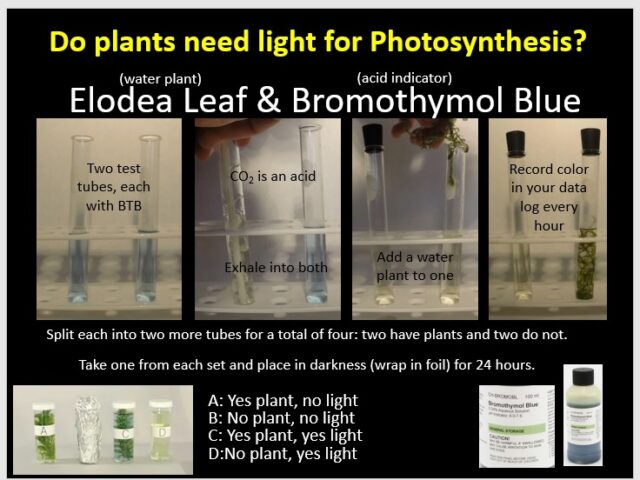
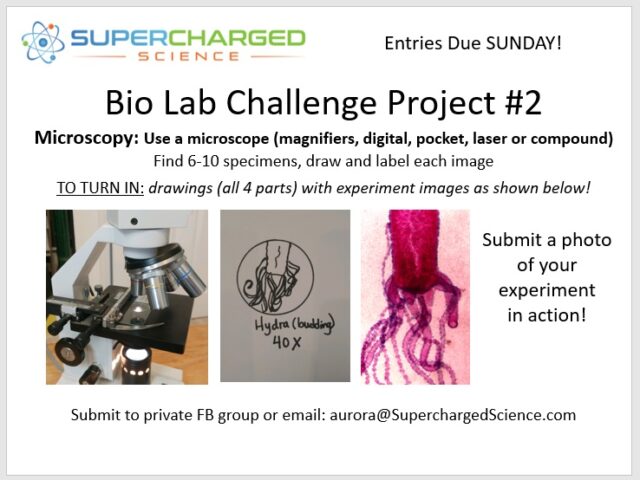
Week 26: Cells & Bio Lab Challenge #3
Microscopes were first invented in 1590, but it wasn't until 1665 that cells were found in living things. From simple bacteria growing in your yogurt to the complex cells in your favorite pet, cells are what makes life on our planet so interesting. Even more amazing is the life going on inside the cell, which scientists are still working to understand today. Cells are the basic unit that hold the equipment needed to keep an organism alive, and we're going to do several different labs to understand the fundamentals.
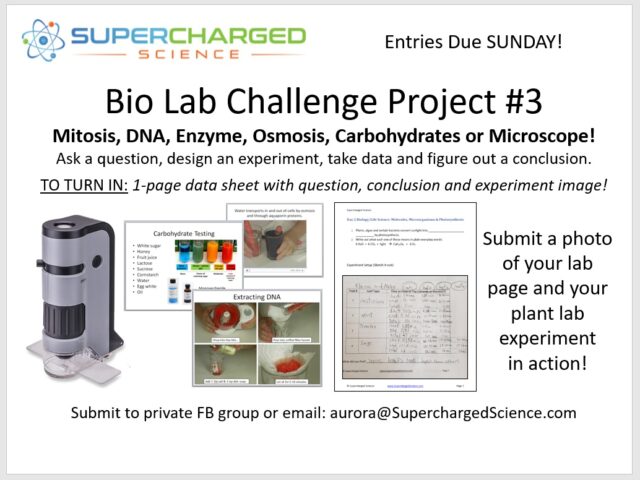
If you've done a couple of our Biology Labs so far, then try the Lab Challenge above - it will give you more to work on this week that will be appropriate for your level. If you're new to doing science labs, use the Lab Challenge below to get you started. It has more detail about specifics for two easy science experiments that you can do. Both images (below and above) are valid for this week's challenge!
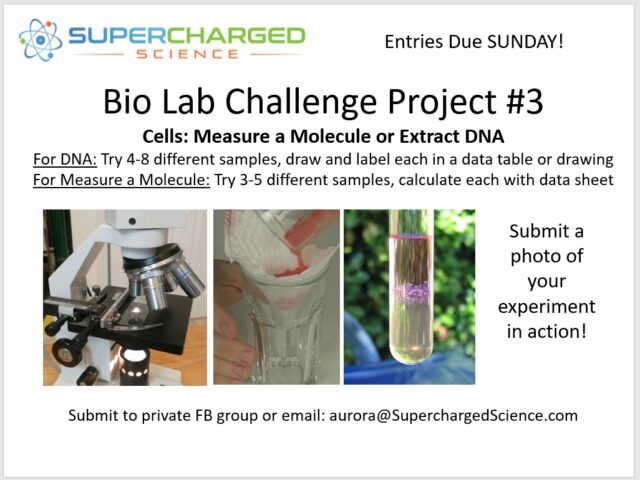
Bonus! Field Trip with a Real Biologist!
The next two videos are recordings from our sessions with biologist Professor Dong. He will be discussing his research in cells and genetics. These videos may not be appropriate for all students, so parents, please preview these before sharing with your students.
Bonus! Field Trip with a Real Microbiologist!
Join Oliver and Aurora for a special hands-on lab in plant and animal cells! If you have a compound microscope, bring it out and follow along. If not, you can still join in and use ours while we work through our class session together. This is a 2-part class!
Week 27: National Engineering Week & Design Competitions
National Engineering Week was created 70 years ago to demonstrate to parents, teachers, and students how important a technical education is for our students. It's a day were local engineering companies, college engineering organizations, and museums host engineering events, science displays, and outdoor fairs to promote math, science, and technology to their local communities. You'll find paper airplane contests by NASA engineers and human powered helicopters flying in shopping malls. (No kidding!) We're going to join in the fun with a cool set of hands-on projects you can do right at home.
We have TWO sets of classes this week to celebrate National Engineering Week! The first set of classes are with Aurora and includes six design challenges. You'll need materials for these challenges (they are easy to get) and you can download the material list here.
The two videos below are Aurora's Design Challenges!
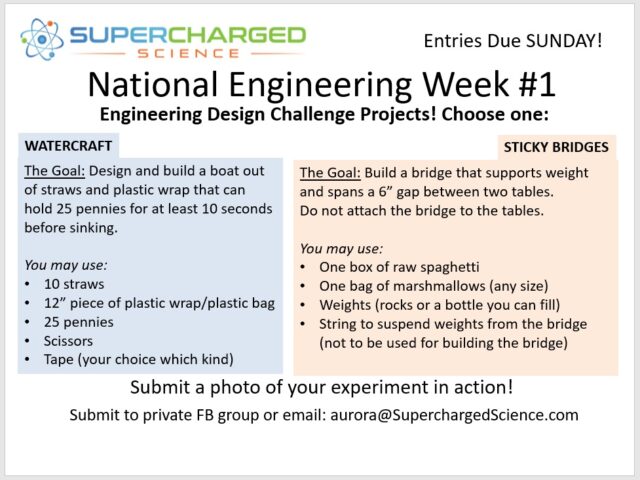
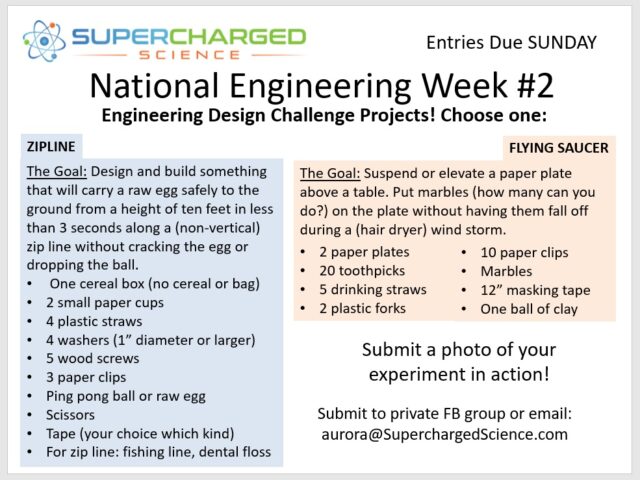
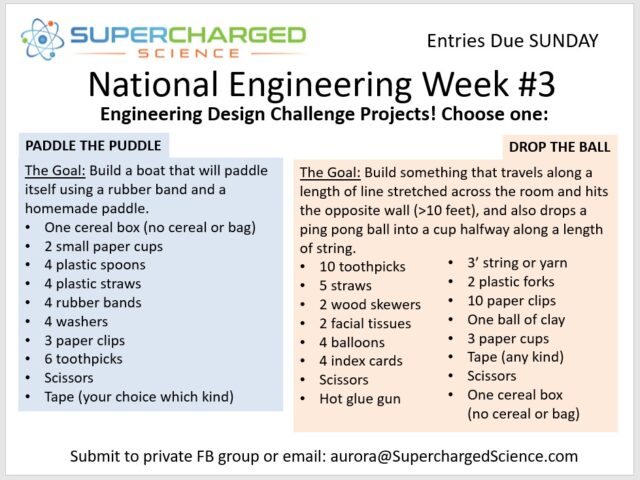

Electronics with Brian
The second set of classes are with Brian (these are immediately following Aurora's classes), and they will cover electronics. You'll need a special of materials to build your circuits, and you can find this list here on page 2 OR purchase a kit directly from Brian at Future Vision Research.
